Physical Address
304 North Cardinal St.
Dorchester Center, MA 02124
The most recent demographic update provided by the National Spinal Cord Injury Statistical Center in 2016 estimates that there are approximately 17,000 new cases of spinal cord injury (SCI) every year. Motor vehicle accidents are the cause of nearly 40% of cases, and almost 70% of cases are incomplete injuries. The societal cost is immense: mean hospital stay is 11 days from the time of injury, followed by a mean of 35 days spent participating with in-patient rehabilitation services; only 12% of individuals return to work by the 1-year anniversary of their injury, lifetime costs can total upwards of $5 million in instances of cervical tetraplegia, and life expectancy is inversely related to the level and completeness of injury. Thus SCI constitutes a major burden to our healthcare system.
Patients with suspected SCI must be identified and triaged at the scene by trained emergency medical service providers. The most effective means of immobilization is the rigid back-board used in combination with rigid cervical collar. The use of sandbags should be entertained only in instances of suspected or confirmed atlantooccipital dislocation (AOD), because any application of a distractive force (i.e., through a rigid cervical collar) may lead to neurologic deterioration. Furthermore, worsened outcome has been noted if the initiation of the Advanced Trauma Life Support algorithm is delayed for any reason, including even the time taken to externally immobilize the spine. Thus resuscitation takes precedence over immobilization, and to this end, spinal immobilization is not recommended acutely in individuals with penetrating systemic trauma. Once stabilized, patients should be transported to the nearest echelon of care capable of managing the injuries. Ideally this would involve transport to a facility that specializes in treatment of SCI.
The clinical assessment of the individual with suspected SCI begins at the scene of the accident. Individuals meeting the NEXUS criteria can be considered to be free of injury to the cervical spine or spinal cord. These criteria are summarized in Fig. 159.1 . , For individuals with evidence of SCI, the guidelines published by the American Spinal Injury Association (the ASIA Impairment Scale) are the most useful tool for describing the residual level of neurologic function, as well as following the injury from the initial assessment, through any required operative treatment, and finally through rehabilitation.
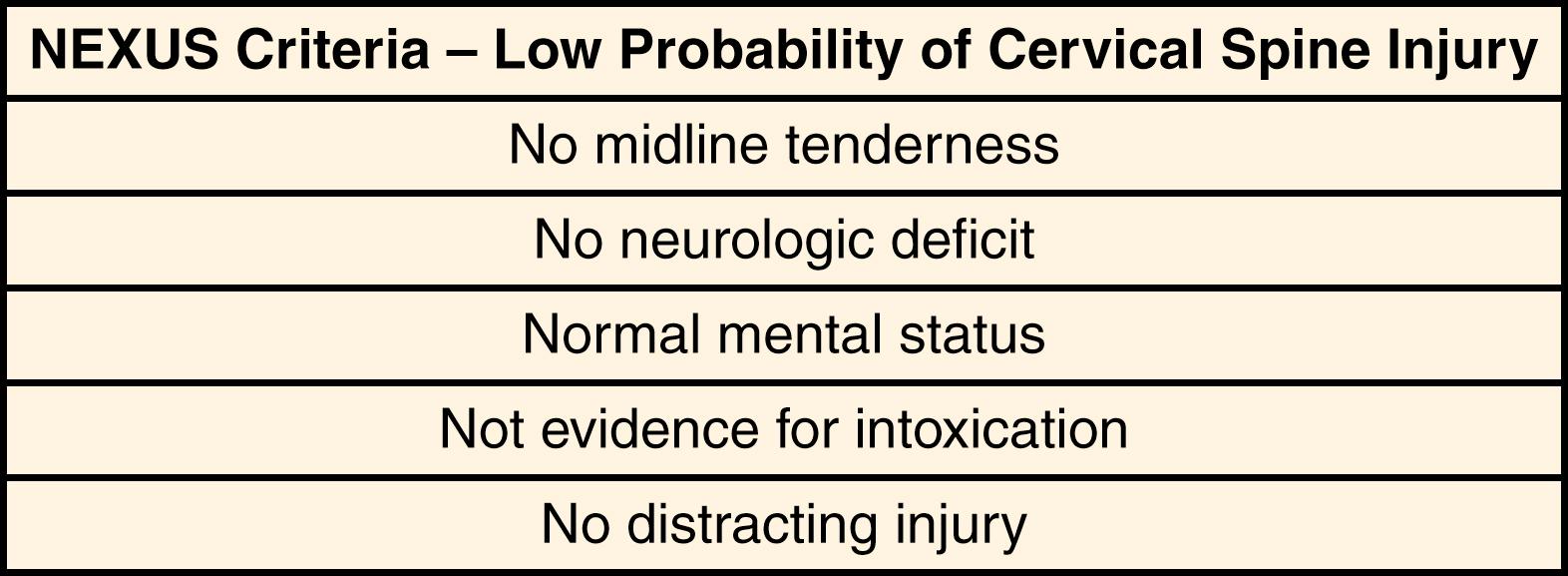
For individuals unable to be cleared clinically using the NEXUS criteria, a radiographic work-up is initiated. With the widespread availability of computed tomography (CT), plain radiography has little practical utility nowadays. Thus, for the awake and symptomatic patient, the radiologic work-up most typically begins with a CT. , In the instance of a normal CT, the likelihood of overlooking a lesion that would require surgery is extremely low. Still, magnetic resonance imaging (MRI) and flexion-extension radiography are available to rule out capsuloligamentous injury if concern persists. Using either method in the acute phase should be weighed carefully because both studies have their limitations: axial pain may prevent adequate excursion on dynamic imaging, limiting its utility in detecting instability; MRI, even if obtained within 48 hours, has been criticized for being oversensitive to ligamentous strain, and furthermore lacks cost-effectiveness as it is extremely unlikely to uncover surgical injures missed by CT alone. Use of these modalities is left to the treating physician; however, one compromise may be continuation of immobilization until symptoms recede, with performance of MRI versus dynamic radiography at that time.
For the unevaluable patient, the algorithm is similar, with the caveat that forced dynamic imaging (i.e., CT with traction, flexion and extension through forced manipulation under fluoroscopy, etc.) is not recommended. In addition, the use of a rigid collar in the obtunded patient has the potential for severe consequences; prolonged immobility and depressed level of consciousness may contribute to pressure ulceration formation of the posterior occiput, or along the mandible, sternum, or clavicles, where the collar rests. Thus for many authors, the decision is often between removal of the collar based on CT findings, versus obtaining an MRI, although as noted earlier, MRI is unlikely to sway management towards surgery.
Penetrating injury to the zones of the neck are grounds for vascular imaging, even without clear spinal involvement. A spinal dislocation, or fracture line with extension into the vicinity of the foramen transversaria, is enough to injure the vertebral arteries and should be investigated with vascular imaging. Blunt injuries can also cause vessel injury, including arterial dissection. The Denver Criteria are a useful set of easily applicable clinical and radiographic findings that may lead one to maintain a low suspicion for occult blunt vascular injury. These criteria are shown in Fig. 159.2 .
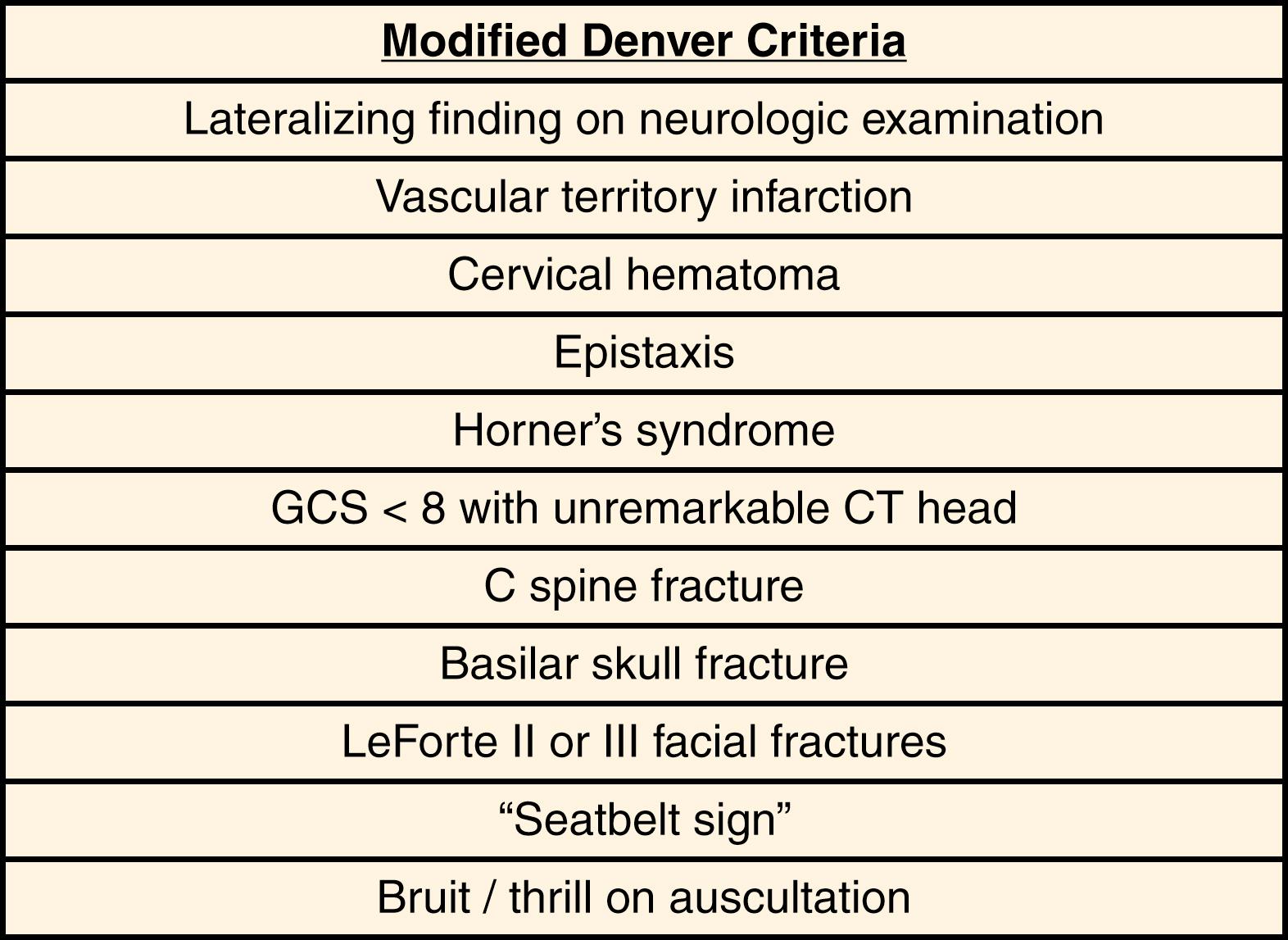
The best means of detecting injury to the cervical vasculature is open to debate. Many level I trauma centers have algorithms in place for contrast-enhanced whole-body CT scans used in the trauma population, which among other sequences include CT angiography of the head and neck. Magnetic resonance angiography is another option; however, it requires a greater acquisition time and is perhaps less readily available, and MRI can be a dangerous place for an unstable patient. If an MRI is to be obtained for further assessment of an injury to the cervical spine, T1-weighted MRI can be extremely good at detecting the luminal irregularity of a vascular injury.
Treatment of vascular injury depends on the lesion’s morphology. Typically, arterial injuries that are asymptomatic or without high-grade luminal stenosis are best addressed with antiplatelet agents such as aspirin. Higher-grade injuries, as well as those that are progressive or symptomatic through embolic phenomena, may require escalating levels of antiplatelet or anticoagulant therapy. Near-complete occlusions or complete transactions are, in some instances, best treatment through endovascular means, including vessel sacrifice.
Attempt at closed reduction of a fracture, particularly in instances of perched or jumped facets, may be worthwhile in some patients. A successful closed reduction may simplify the operative treatment algorithm, potentially converting an unreduced injury that is in need of circumferential decompression, reduction, and fusion into a shorter, single-stage procedure. Closed reduction with traction is ill-advised in instances of an additional, more rostral injury. There is some controversy regarding the necessity of MRI obtained prior to attempt at reduction, because reports of transient as well as permanent neurologic decline exist in the literature. The preponderance of data suggests that prereduction MRI findings do not influence neurologic outcome in the individual who is awake and cooperative. However, MRI is recommended in the unevaluable patient prior to any attempt at reduction. The wide availability of rapid MRI protocols have, to some extent, made this a moot point, and in most cases it is easy to obtain prereduction imaging.
Closed reduction can be difficult, particularly if not undertaken for several days after the injury, and at lower cervical levels; in addition, reduction often requires significantly more weight than the 7 to 10 pound per level that is the official recommendation. , , , Traction in combination with flexion is typically the required maneuver to reduce “perched” or “jumped” facets; a unilateral jumped facet will also generally require some degree of added rotation away from the side of the pathology. Fortunately, open reduction is possible from all approaches. From an anterior approach, divergent Caspar pin placement coupled with ventral compression, which distracts at the level of the posterior uncovertebral joint, is often sufficient to reduce a jumped facet ( Figs. 159.3 and 159.4 ). An alternative or perhaps concomitant approach is to use the distractive force of placement of an interbody graft or manual traction to achieve reduction. Posteriorly, the task may be easier—one may grasp the nearest adjacent intact posterior elements that lie cranial and caudal to the level of injury and, with simultaneous distraction and derotation, may restore normal alignment of the facet complex. Fig. 159.5A-C represent the intake CT of a young male patient who presented with an ASIA B type injury to the cervical cord after a fall from height. The CT demonstrated subluxation at C5–6, with bilateral facet dislocation. MRI ( Fig. 159.6 ) demonstrates complete disruption of the C5–6 disc and capsuloligamentous complex at this level, with abnormal T2 signal within the cord itself. The patient was treated with posterior open reduction, decompression, and fixation ( Fig. 159.7 ).
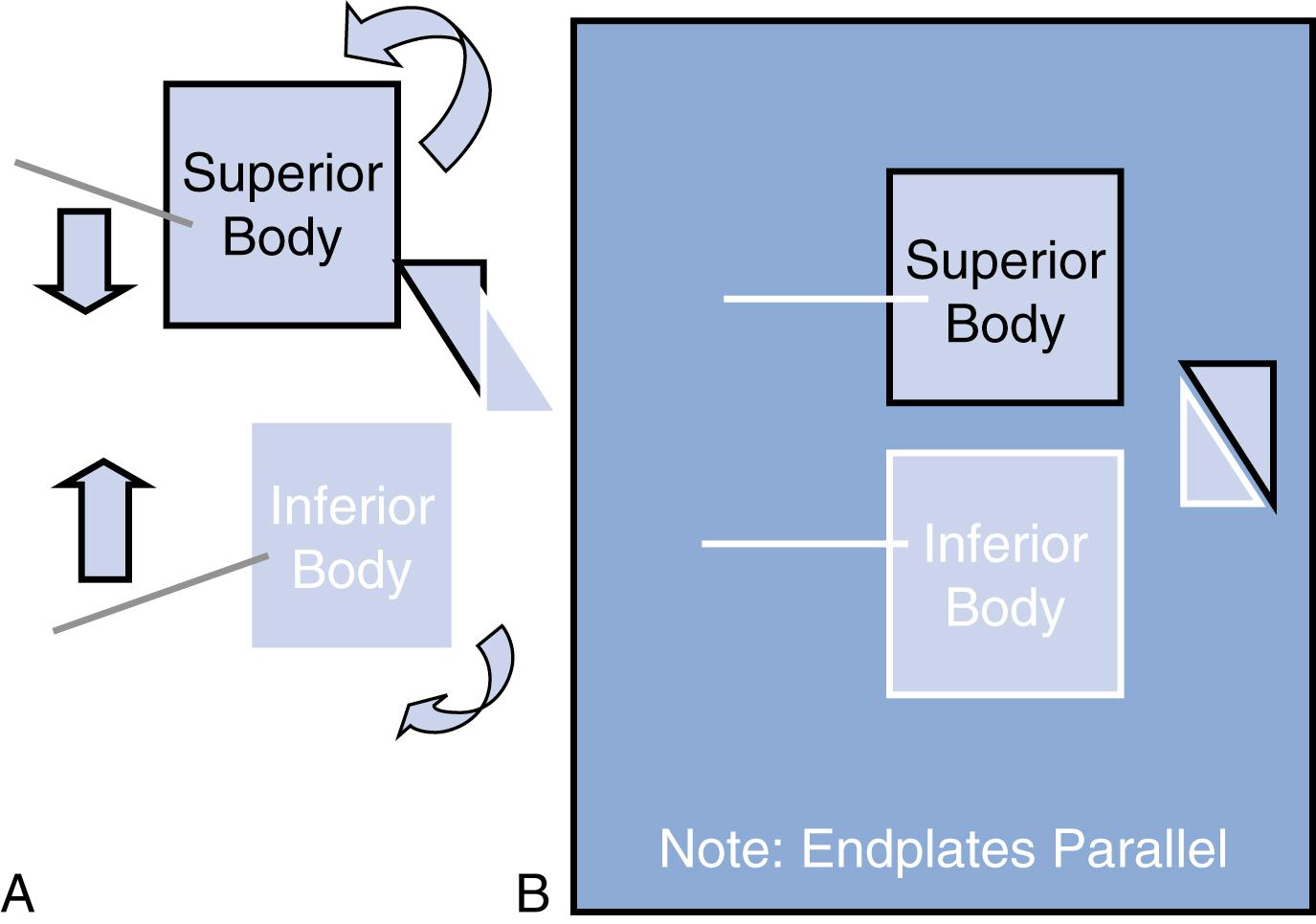
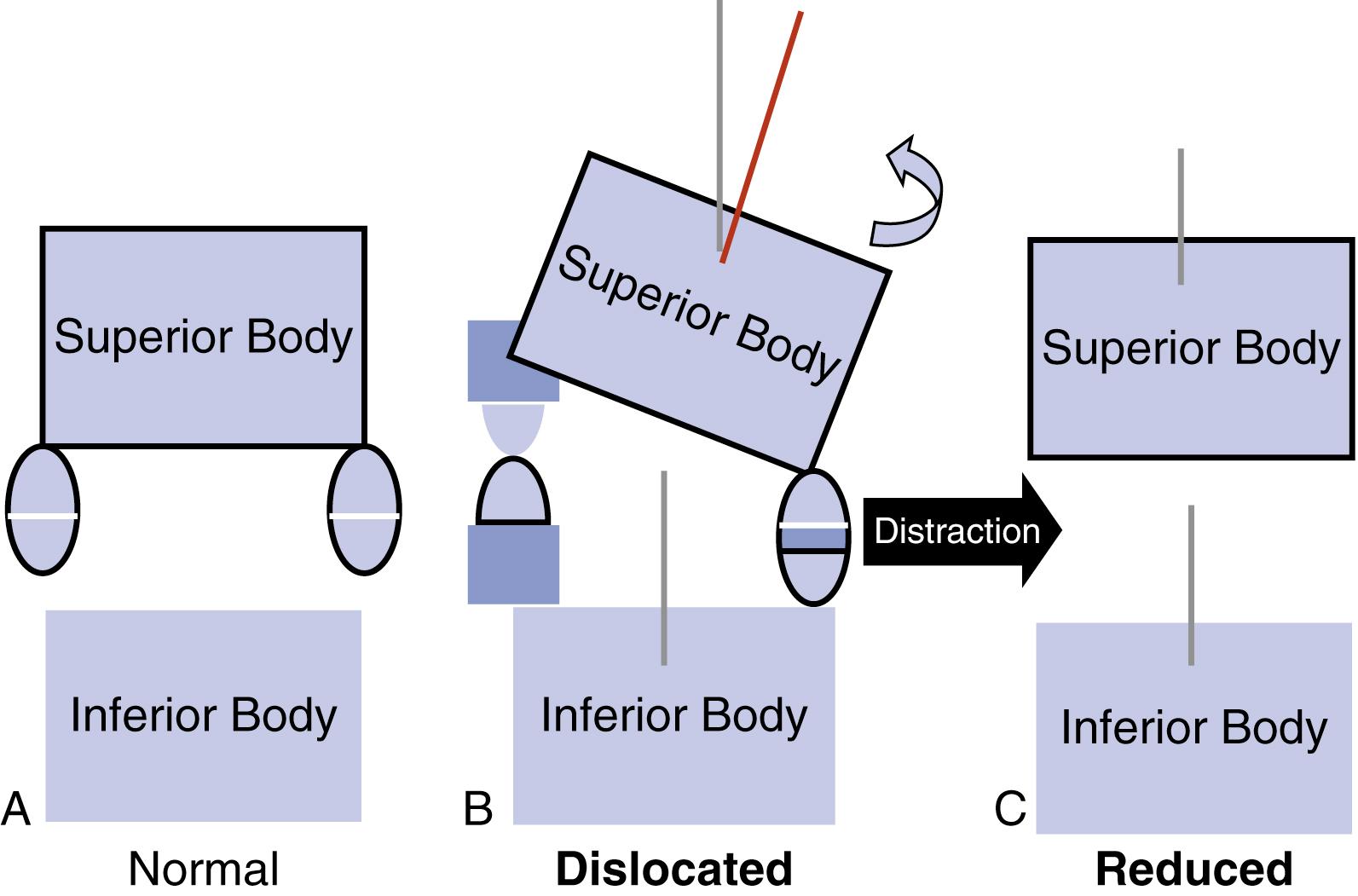
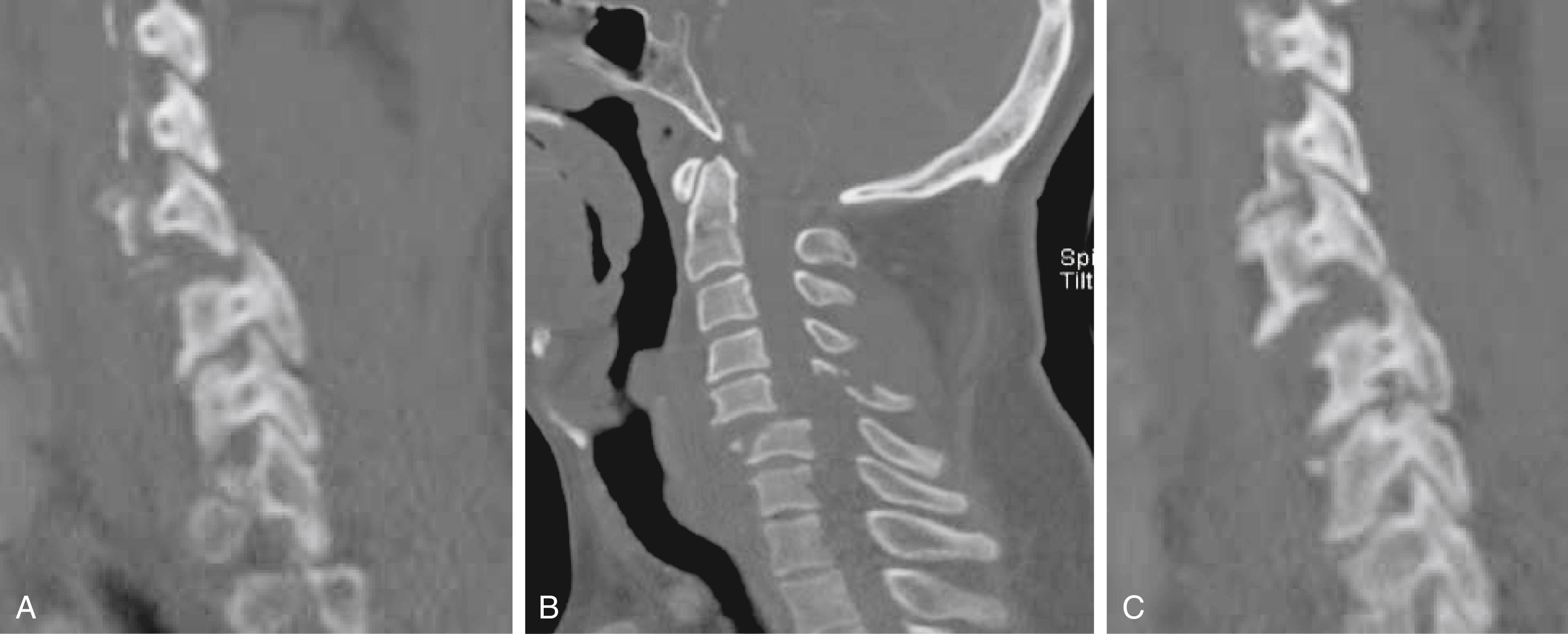
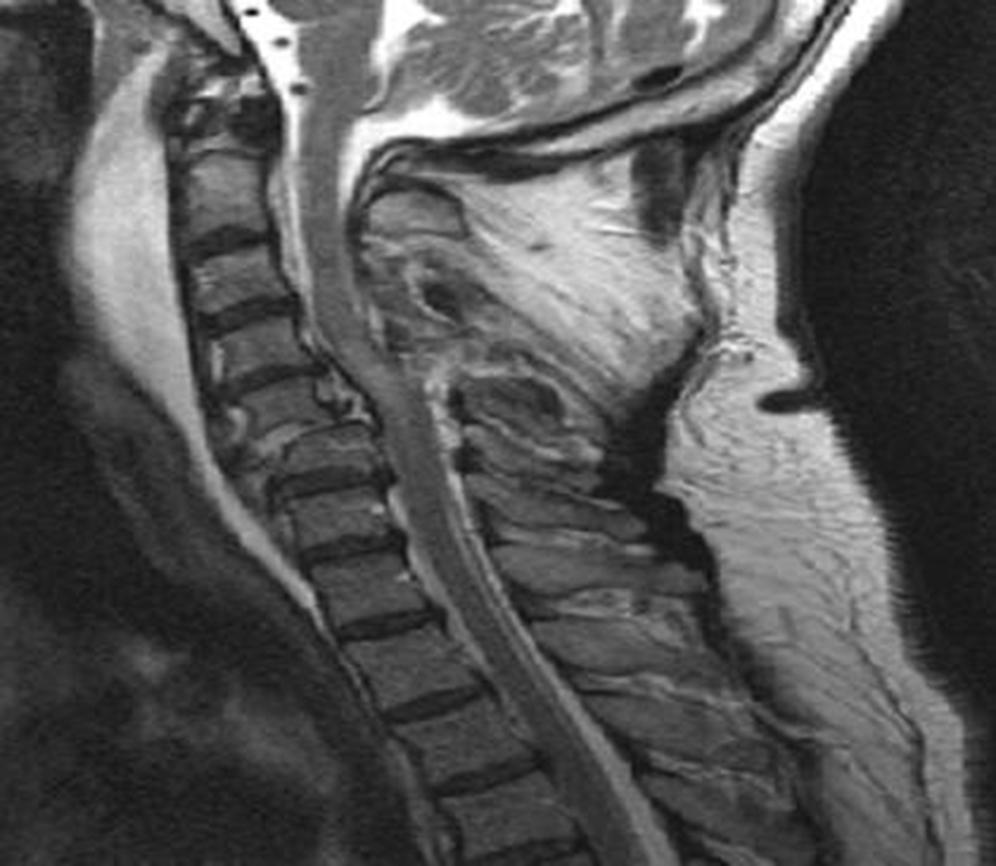
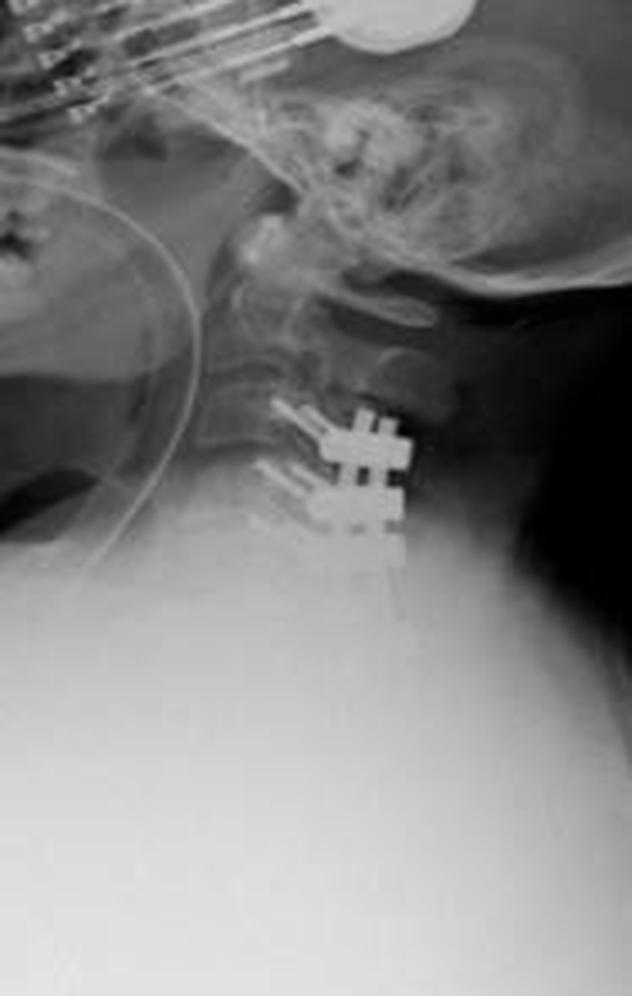
Become a Clinical Tree membership for Full access and enjoy Unlimited articles
If you are a member. Log in here